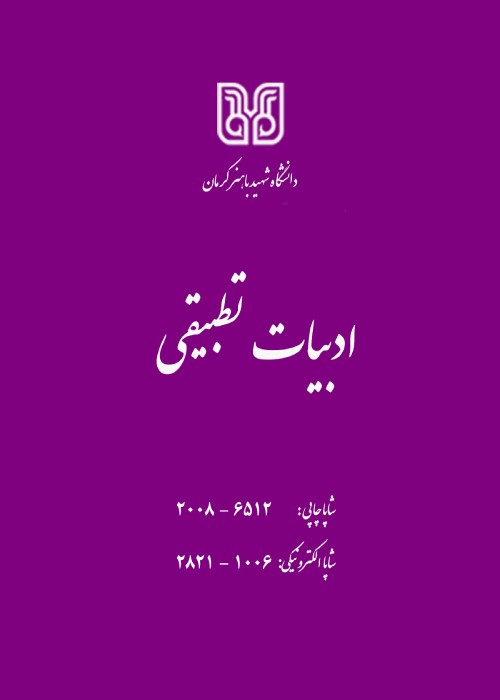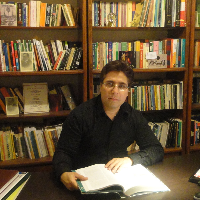A Comparative Study of Persian Vasookht Ghazal and English Anti-Petrarchan Sonnet and thier Social, Cultural, and Historical Backgrounds: A Case-study of Vahshi Bafghi and William Shakespeare
Comparing the long-life Persian ghazal with the short-life but productive English sonnet, one discerns the slow and continuous development of ghazal on the one hand, and the rapid change of sonnet in a short period of time on the other. English sonnet has its own history back in the Middle Ages when lyric poetry was growing immediately after the Old English verse. Ghazal has been approached differently and critics are inclined to divide it based on topic, history, and style. Therefore, in one taxonomy it is amorous or mystic, in another it is classified based on the historical assumptions. Razmju, after giving a comprehensive historical judgment, refers to its major origin (Razmju, 2011: 86-9). In short, lyrics were initiated in the Persian poetry right with the emergence of Dari language in the ninth century. The oldest form of it can be observed in the poetry of Hanzale ye Bādqisi (d. 219/850). In the tenth century, the cultivation of ghazal was manifested, and both Rudaki and Shahid e Balḵi (d. 325/935) composed elegant lyrics and amorous poetry. Later at the beginning of the Eleventh century, Farroḵi ye Sistāni (d. 429/1037) assimilated ghazal with Taghazzol so that in the succeeding century ghazal evolved into a new accepted style by great poets such as Sanā’i (d. 545/1134), Mawlānā (d. 672/1273), Attār (d. 618/1221), and Irāqi (d. 688/1289). Gradually, the division of amorous/mystic became increasingly apparent. The culmination of amorous ghazal was with Sa’di (d. 691/1292) while the bloom of mystic ghazal was with Mawlānā. Then, the integration of these two was flourished in the fourteenth century most well-known poet Hāfez (d. 792/1390).European sonnet, accompanying the English one, owes its existence to the Italian poetic heritage of the thirteenth century. In the mid-fourteenth century, Petrarch (d. 1374) occupied a significant place in the Italian love poetry. The new form of sonnet came to other European countries in the following centuries. Hence, some bibliographers tend to call the sixteenth century Europe the arena of sonnet (Vaganay, 1966: xv). English sonnet spread across the literary aura roughly between 1580 and 1600. England, in the sixteenth century, found sonnet as a new-born form and many poets attempted to experience the novel genre. In this research, a sonnet by William Shakespeare (1564-1616) and a ghazal by Vahshi Bafghi (1532-1583) were selected to be compared and contrasted in order to indicate and reveal Persian Vasookht and English Anti-Petrarchan lyricism.
This article aims at comparing two schools of lyricism in Persian and English Poetry, Vasookht and Voqu (Ocurrence-telling) and Anti-Petrarchism. The research aims at applying a descriptive-analytical approach while insisting on American school of comparative studies and positing Veselovsky’s historico-cultural comparative theory which reveals how world literatures are closely related to each other though they are not directly influenced by.
Both ghazal and sonnet with their well-made exquisite structure, miniature and elegant form, and complex content are the excellent literary genres where one may perceive in them common aspects and proportions. Among these aspects are the topics of “Vasookht” or turning from the beloved in Persian ghazal and anti-Petrarchism in English sonnet. Ghazal in Persian poetry, undoubtedly, occupies a significant place and enjoys a long history comparing the English sonnet. Vasookht in Persian poetry was a much more complicated phenomenon which depended on many social and political factors; the most important ones are: objectivism and avoiding subjectivity of the earlier Iraqi School; disclosing lover’s real emotions and sentiments; emphasizing realities and making believe; insisting earthly and terrestrial love; grossness and vulgarity in language; informal and colloquial speech; expressing same-sex-love openly; uttering real emotions of anger and hate. Incidentally, Vasookht had its own social and political dimensions; some of the most important ones are: Solidarity in politics, economics, religion, and culture in Safavid period and helping the poets to show a more dependent picture of themselves and their high expectations in ghazals; the influences of the Indian culture on Persian ghazal which established a new lover-beloved speaker; emphasis on objectivism in poetry and avoiding the abstract ideas and the ideal heavenly love common in earlier periods of ghazal; ghazal approached the public, and new poets of lower classes of Iranian society started to compose lyrics and consequently a new mode of language and speech was shaped in ghazals. Furthermore, English sonnet moved fast in its alteration and witnessed rapid changes in mode and conventions. Indeed, the Renaissance in Europe and England was a vast phase and complicated era of experiencing various forms and styles. In poetry, also alterations were prompt and poets were deeply involved in the trends. Persian Vasookht and English anti-Petrarchism share some common features; however, their causes are not necessarily the same. English sonneteers did not follow the continent’s major lyricists in retaining romantic tradition due to their expectations and ideals. Based on what pursued in this research, the English anti-Petrarchism rests on some factors which are mostly related to the English literary taste and character. Some of these factors are: the un-Petrarchan convention was rooted in the English culture even before the rise of Petrarchism in the English Renaissance; the contradictory articulation of praise and blame in the English sonnet seems to be a site of English complicated and vague spirit and talent; Petrarchism and anti-Petrarchism in English sonnet do not embody a clear-cut distinction.
Both Persian and English lyrics witnessed metamorphosis in depicting the beloved in the course of their developments. Change of lover/poet’s accounts of the beloved fell upon the lyric tradition of both Persian Vasookht ghazal (Turning from the beloved) and English anti-Petrarchan sonnets. Persian ghazal, the full-fledged amorous poems, went through “Maktab-e Woqu” (Occurrence-telling) at the sixteenth and seventeenth centuries when poets tended to reveal their true emotions based on the realities and facts surrounding them. Vasookht was a subgenre of Maktab-e Woqu in which the despaired and provoked lover/poet left praising the beloved and began to blame and humiliate her/him. Besides, many of the English poets of the sixteenth and seventeenth centuries drew at a beloved far from the Petrarchan ideals, deflated romantic tradition of love, and anti-Petrarchism was established in English poetry. Thereby this article attempted to posit a historico-cultural re-vision of Vasookht in Persian ghazal and anti-Petrarchism in English sonnet while clarifying some of their most significant cultural aspects.
- حق عضویت دریافتی صرف حمایت از نشریات عضو و نگهداری، تکمیل و توسعه مگیران میشود.
- پرداخت حق اشتراک و دانلود مقالات اجازه بازنشر آن در سایر رسانههای چاپی و دیجیتال را به کاربر نمیدهد.



